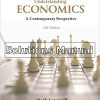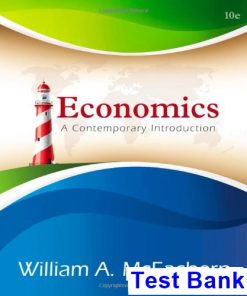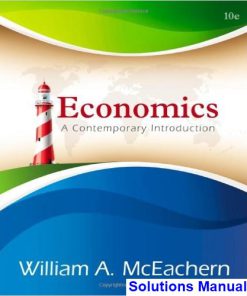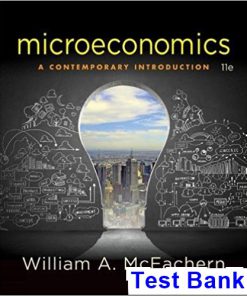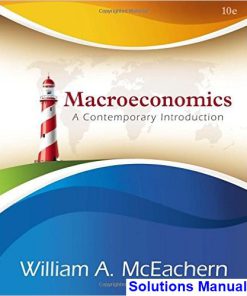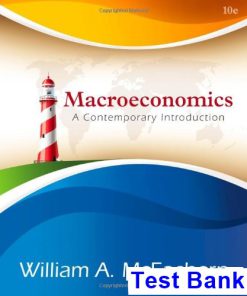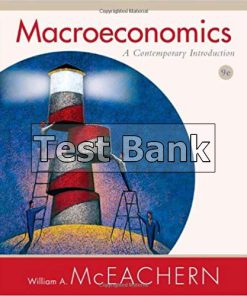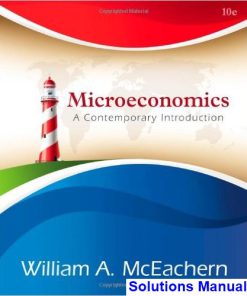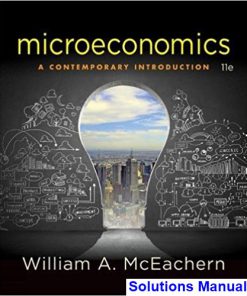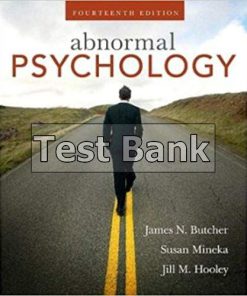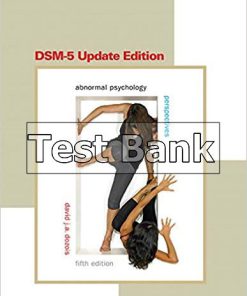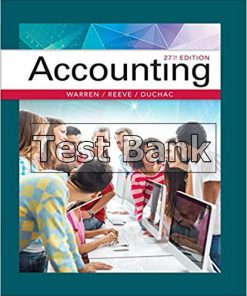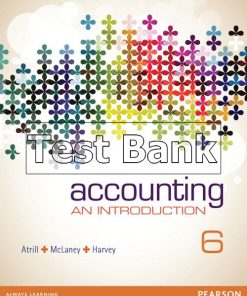Macroeconomics A Contemporary Introduction 11th Edition McEachern Test Bank
$50.00 Original price was: $50.00.$26.50Current price is: $26.50.
Macroeconomics A Contemporary Introduction 11th Edition McEachern Test Bank.
This is completed downloadable of Macroeconomics A Contemporary Introduction 11th Edition McEachern Test Bank
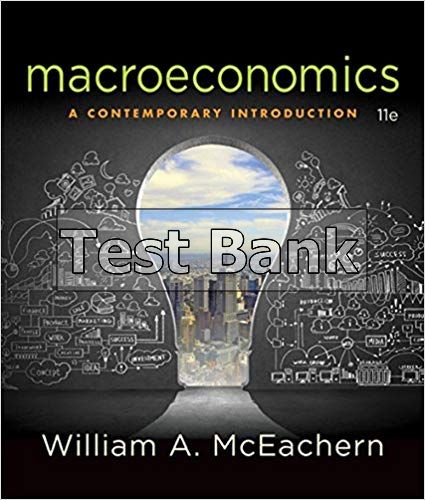
Product Details:
- ISBN-10 : 1305505492
- ISBN-13 : 978-1305505490
- Author: William A. McEachern
Now you can “teach by example” with the unique approach to economics found only in McEachern’s acclaimed MACROECONOMICS: A CONTEMPORARY INTRODUCTION, 11E. The text uses examples and illustrations that your students will recognize when they show up for class the first day, because they already have at least 17 years of personal experience with economic choices, institutions, and events. This book truly leads by example, taking a “just-in-time” approach that introduces material just as it is needed to develop an argument. Clear and interesting exposition combines with case studies, recent research findings, and a focused design. Relevant case studies are integrated into the flow of each chapter. Each chapter includes a one-page case study in the printed book as well as a second case study online. The book’s well-crafted approach is enhanced with resources, such as Aplia and MindTap, that help improve student understanding and help you streamline tasks and save valuable time.
Table of Content:
- Ch 1: The Art and Science of Economic Analysis
- 1-1: The Economic Problem: Scarce Resources, Unlimited Wants
- 1-2: The Art of Economic Analysis
- 1-3: The Science of Economic Analysis
- 1-4: Conclusion
- Summary
- Key Concepts
- Questions for Review
- Problems and Exercises
- Appendix: Understanding Graphs
- Ch 2: Economic Tools and Economic Systems
- 2-1: Choice and Opportunity Cost
- 2-2: Comparative Advantage, Specialization, and Exchange
- 2-3: The Economy’s Production Possibilities
- 2-4: Economic Systems
- 2-5: Conclusion
- Summary
- Key Concepts
- Questions for Review
- Problems and Exercises
- Ch 3: Economic Decision Makers
- 3-1: The Household
- 3-2: The Firm
- 3-3: The Government
- 3-4: The Rest of the World
- 3-5: Conclusion
- Summary
- Key Concepts
- Questions for Review
- Problems and Exercises
- Ch 4: Demand, Supply, and Markets
- 4-1: Demand
- 4-2: What Shifts a Demand Curve?
- 4-3: Supply
- 4-4: What Shifts a Supply Curve?
- 4-5: Demand and Supply Create a Market
- 4-6: Changes in Equilibrium Price and Quantity
- 4-7: Disequilibrium
- 4-8: Conclusion
- Summary
- Key Concepts
- Questions for Review
- Problems and Exercises
- Ch 5: Introduction to Macroeconomics
- 5-1: The National Economy
- 5-2: Economic Fluctuations and Growth
- 5-3: Aggregate Demand and Aggregate Supply
- 5-4: A Brief History of the U.S. Economy
- 5-5: Conclusion
- Summary
- Key Concepts
- Questions for Review
- Problems and Exercises
- Ch 6: Tracking the U.S. Economy
- 6-1: The Product of a Nation
- 6-2: Circular Flow of Income and Expenditure
- 6-3: Limitations of National Income Accounting
- 6-4: Accounting for Price Changes
- 6-5: Conclusion
- Summary
- Key Concepts
- Questions for Review
- Problems and Exercises
- Appendix: National Income Accounts
- Ch 7: Unemployment and Inflation
- 7-1: Unemployment: Its Measure and Sources
- 7-2: Other Unemployment Issues
- 7-3: Inflation: Its Measure and Sources
- 7-4: Effects of Inflation
- 7-5: Conclusion
- Summary
- Key Concepts
- Questions for Review
- Problems and Exercises
- Ch 8: Productivity and Growth
- 8-1: Theory of Productivity and Growth
- 8-2: Productivity and Growth in Practice
- 8-3: Other Issues of Technology and Growth
- 8-4: Conclusion
- Summary
- Key Concepts
- Questions for Review
- Problems and Exercises
- Ch 9: Aggregate Demand
- 9-1: Consumption
- 9-2: Nonincome Determinants of Consumption
- 9-3: Other Spending Components
- 9-4: Aggregate Expenditure and Income
- 9-5: The Simple Spending Multiplier
- 9-6: The Aggregate Demand Curve
- 9-7: Conclusion
- Summary
- Key Concepts
- Questions for Review
- Problems and Exercises
- Ch 10: Aggregate Supply
- 10-1: Aggregate Supply in the Short Run
- 10-2: From the Short Run to the Long Run
- 10-3: Aggregate Supply in the Long Run
- 10-4: Changes in Aggregate Supply
- 10-5: Conclusion
- Summary
- Key Concepts
- Questions for Review
- Problems and Exercises
- Ch 11: Fiscal Policy
- 11-1: Theory of Fiscal Policy
- 11-2: Fiscal Policy Up to the Stagflation of the 1970s
- 11-3: Limits on Fiscal Policy’s Effectiveness
- 11-4: Fiscal Policy from 1980 to 2007
- 11-5: Fiscal Policy during and after the Great Recession
- 11-6: Conclusion
- Summary
- Key Concepts
- Questions for Review
- Problems and Exercises
- Appendix: Demand-Side Effects of Government Purchases and Net Taxes
- Ch 12: Federal Budgets and Public Policy
- 12-1: The Federal Budget Process
- 12-2: Fiscal Impact of the Federal Budget
- 12-3: The National Debt in Perspective
- 12-4: Federal Debt and the Economy
- 12-5: Conclusion
- Summary
- Key Concepts
- Questions for Review
- Problems and Exercises
- Ch 13: Money and the Financial System
- 13-1: The Birth of Money
- 13-2: Money and Banking
- 13-3: Financial Institutions in the United States
- 13-4: Banking during and after the Great Recession of 2007-2009
- 13-5: Conclusion
- Summary
- Key Concepts
- Questions for Review
- Problems and Exercises
- Ch 14: Banking and the Money Supply
- 14-1: Money Aggregates
- 14-2: How Banks Work
- 14-3: How Banks Create Money
- 14-4: The Fed’s Tools of Monetary Control
- 14-5: Conclusion
- Summary
- Key Concepts
- Questions for Review
- Problems and Exercises
- Ch 15: Monetary Theory and Policy
- 15-1: The Demand and Supply of Money
- 15-2: Money and Aggregate Demand in the Short Run
- 15-3: Money and Aggregate Demand in the Long Run
- 15-4: Targets for Monetary Policy
- 15-5: Conclusion
- Summary
- Key Concepts
- Questions for Review
- Problems and Exercises
- Ch 16: Macro Policy Debate: Active or Passive?
- 16-1: Active Policy versus Passive Policy
- 16-2: The Role of Expectations
- 16-3: Policy Rules versus Discretion
- 16-4: The Phillips Curve
- 16-5: Conclusion
- Summary
- Key Concepts
- Questions for Review
- Problems and Exercises
- Ch 17: International Trade
- 17-1: The Gains from Trade
- 17-2: Trade Restrictions and Welfare Loss
- 17-3: Efforts to Reduce Trade Barriers
- 17-4: Arguments for Trade Restrictions
- 17-5: Conclusion
- Summary
- Key Concepts
- Questions for Review
- Problems and Exercises
- Ch 18: International Finance
- 18-1: Balance of Payments
- 18-2: Foreign Exchange Rates and Markets
- 18-3: Other Factors Influencing Foreign Exchange Markets
- 18-4: International Monetary System
- 18-5: Conclusion
- Summary
- Key Concepts
- Questions for Review
- Problems and Exercises
- Ch 19: Economic Development
- 19-1: Worlds Apart
- 19-2: Productivity: Key to Development
- 19-3: International Trade and Development
- 19-4: Foreign Aid and Economic Development
- 19-5: Conclusion
- Summary
- Key Concepts
- Questions for Review
- Problems and Exercises
- Glossary
- Index
People Also Search:
macroeconomics a contemporary introduction mceachern
macroeconomics a contemporary introduction 11th edition mceachern
macroeconomics a contemporary introduction 11th edition
macroeconomics a contemporary introduction 11th edition testbank download pdf
macroeconomics a contemporary introduction 11th edition download scribd
macroeconomics a contemporary introduction
Instant download after Payment is complete
You may also like…
Related products
Test Bank



